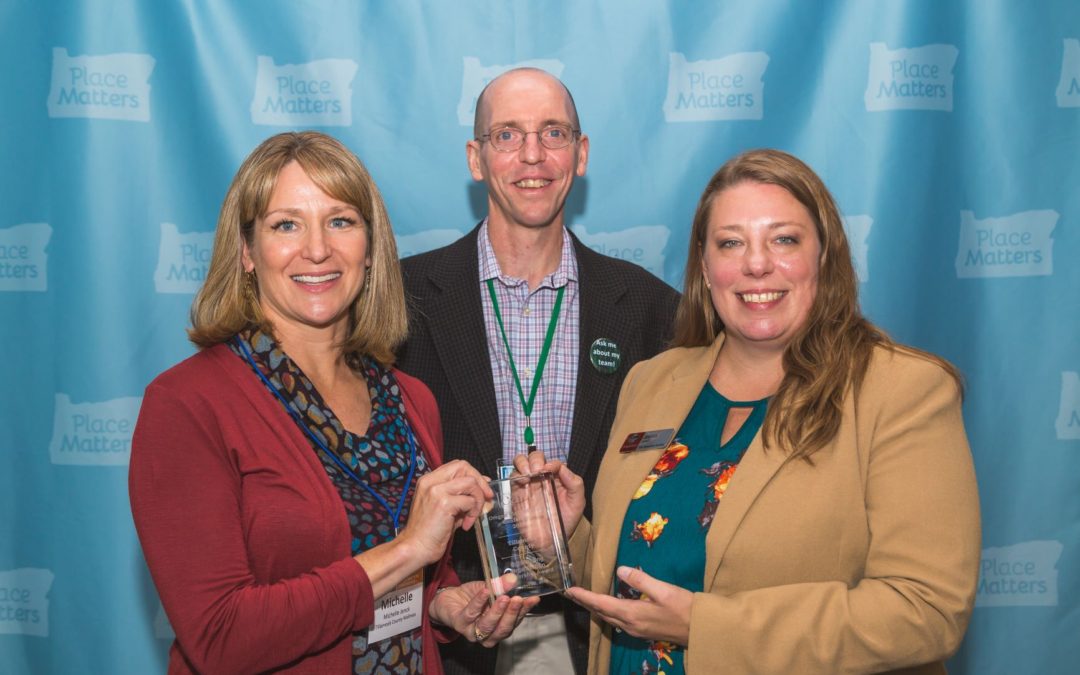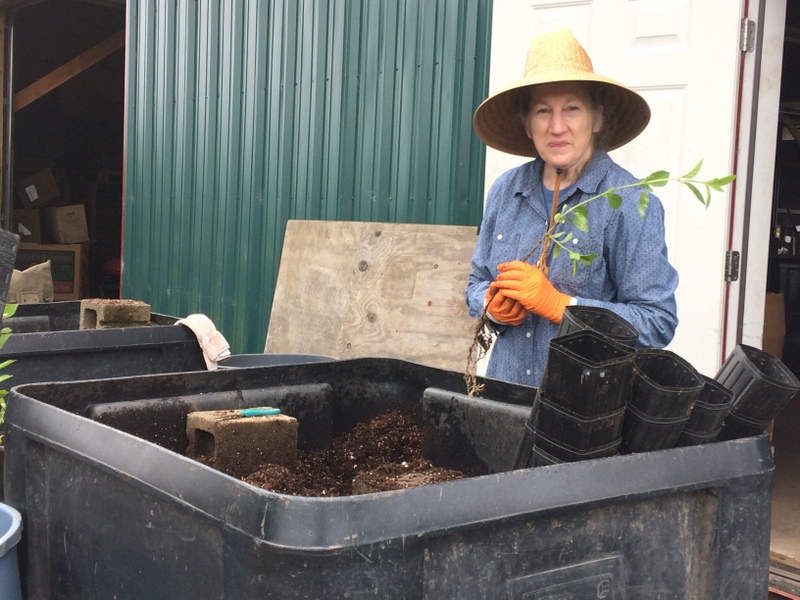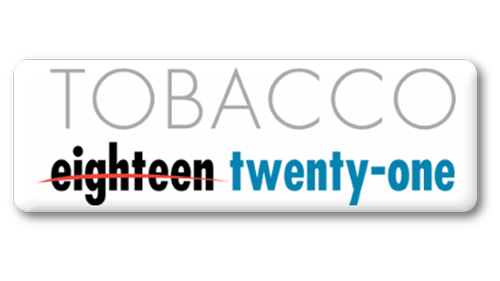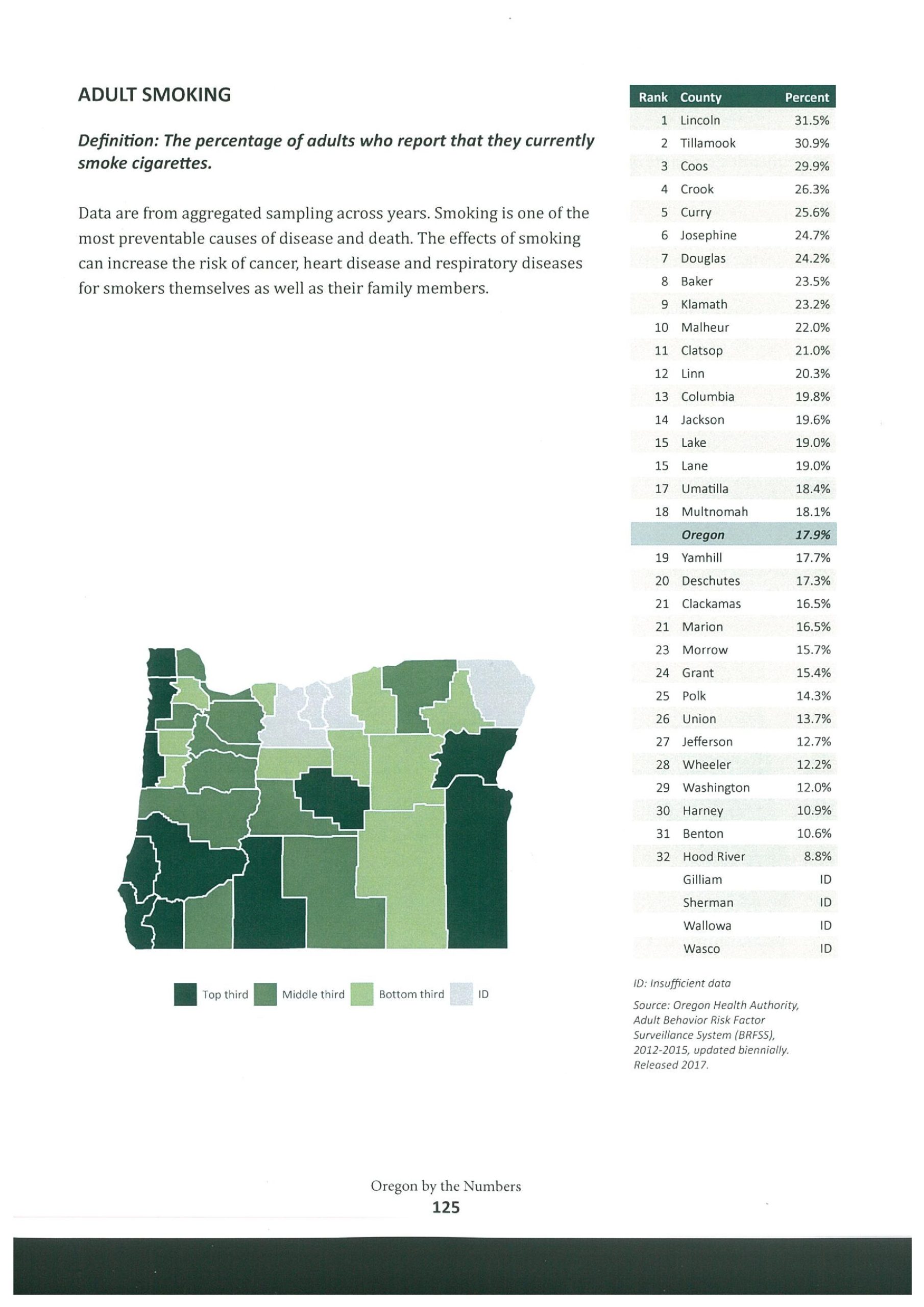
by Michelle | Dec 7, 2018 | Being Well
Time flies when you are working on wellness! It’s hard to believe the “Year of Wellness” (now Tillamook County Wellness) is still going strong as it winds down its fourth year. So often, community coalitions are a flash-in-the-pan, dependent on government funding or grants, only to fizzle out when the well runs dry.
We’ve adopted a slightly different approach here in Tillamook County. We’ve developed a shared vision of improving the health of our community. Over these past four years, we’ve built an ever-expanding coalition of community partners who are willing to devote their time, treasure and talents to keep this work moving forward.
The most significant of these contributions comes from our backbone agency, the Tillamook County Community Health Centers and Public Health Department. They are keeping the wheels on the bus, so to speak, by providing coordination and fiscal oversight to the project. It is important to note that these funds do not come from the county’s general fund but rather from the clinic itself.
Another significant contribution this year, came from a generous donation by Adventist Health, Tillamook. Many of our partners have donated vital resources to our continued operation. These are often in-kind, such as all the paid staff time organizations devote to the coordination, planning, and programming involved in changing community health from the ground up.
Our media partners have also helped us get the word out through their contributions of “earned media.” We enjoy monthly interviews on KTIL’s Tillamook Today show (Shameless plug – tune in to 95.9 FM at 9:30 AM on the 2nd Friday of each month for Wellness news!) If you are reading this article, then you are probably aware of the countless inches of newspaper space the Headlight Herald has gifted us through our weekly Wellness column over the past few years. And the Tillamook County Pioneer provides this same level of generous coverage on-line. We are truly blessed indeed. These relationships allow us to devote our limited cash resources to things like community wellness programming, trail building and improved access to nutrition.
The leadership and support of our County Commissioners, Task Force and committee co-chairs, as well as from our leadership team are what keeps the wellness bus on the road and heading in the right direction. Representatives from Oregon State University Extension, Family & Community Health and Oregon Health Sciences University (OHSU) have provided vital services, bringing outside expertise to our local efforts. Through this partnership, we hosted several national experts in the areas of coalition building, community health and diabetes prevention from May through October of this year. The knowledge gained from these workshops has been put to use by our committees as they design specific action plans for 2019 and beyond, a process which is wrapping up at the time of this publication.
The tireless and selfless nature of our coalition partner and volunteer efforts has not gone unnoticed. In October of this year, Tillamook County Wellness was awarded the Oregon Health Authority “Place Matters” Organization Leadership Award. This statewide level of recognition validates that we are truly headed down the right road. It has invigorated our team to press on and see how significant of an impact we can make on improving the health of our county residents.
Focused on reducing risk for Type 2 Diabetes, our Wellness Action Committees include: Access to Healthy Food, Access to Physical Activity, Health Promotion, Health Screenings and Workplace Wellness. For a list of our coalition partners, visit our Community Partner page. If you’d like to join in this work or make a donation, contact tillamookcountywellness@gamil.com. For more information about Tillamook County Wellness, visit our website tillamookcountyhealthmatters.org and remember to Like and Follow us on our Tillamook County Wellness Facebook page.

by Michelle | Nov 29, 2018 | Being Well
By Betsy Bredau
We all find satisfaction being productive, contributing members of our community. For those of us who are retired, our identities and sense of self-worth may have been tightly intertwined with our profession and now that is gone.
Meanwhile, our rural county is blessed with great beauty, but our modest population means that we have an equally modest tax base and not much funding for extra services found in a wealthier, more populous county. Thus, non-profits and volunteer groups fill an important role. Social services, animal shelters, public lands, our hospital, schools and libraries could all use help. Here’s where we seniors come in: we are hard workers, self-disciplined and have old-fashioned common sense. In other words, we are perfect volunteers.
For ideas on how and where to volunteer your time, go to the Tillamook County Giving Guide, at www.tillamookcountypioneer.net and watch for the NEW 2018-19 Giving Guide soon to be in mailboxes throughout the county. Then match against your likes, dislikes, transportation needs, etc. If you try something and don’t like it, try something else until you find the right fit. If nothing appeals to you, or you don’t want to commit or you have no transportation, there is still something you can do. Bring a bag, wear a glove and pick up litter on the street outside your home or on your next walk. Even this small step contributes to a better community.
I chose to volunteer with the Northwest Oregon Restoration Partnership (NORP) nursery, part of the Tillamook Estuaries Partnership (TEP.) The nursery is located adjacent to the Oregon Youth Authority (OYA) facility and is a cooperative effort of the TEP and OYA. My job is to weed small plants and plant seedlings. It may not sound like much, but it’s very satisfying to spend a day weeding four hundred native plants that will be used for salmon habitat restoration.
To my surprise, the most rewarding part of my job at the nursery has been working with the young men who become eligible to work there during the last year of their incarceration. For privacy reasons, I can’t disclose details, but it is apparent to me that our tax dollars are being put to sensible and worthwhile use for the rehabilitation of these guys. The staff does an exceptional job providing an environment to steer these young men in the right direction. It has been a powerful and positive experience that I never would have had if not for my volunteer work.
Volunteering is a like a good run on a beautiful day combined with a productive day at work: you have a sense of accomplishment afterwards and a positive outlook. Try it!

by Michelle | Nov 1, 2018 | Being Well
One food drive is better than two. Tillamook High School’s Associated Student Body (ASB) teamed up with FFA to hold a community-wide canned food drive last week. The effort was a huge success, bringing in a grand total of over 4500 food items in just 5 days, a significant increase over last year’s haul of about 1000 items.
Student-led support of our local Food Bank has been happening for years. Both the ASB and FFA have been conducting their own annual food drives for as long as anyone can remember. The secret to this year’s success can be summed up in two words: Teamwork and Fun.
This year, organizers decided to try some new tactics. In addition to combining the two separate food drives into one, they added daily incentives and competitions to increase participation. The senior and freshmen classes competed as one team against the combined junior and sophomore classes. They offered “food-for-food” incentives like getting 2 cookies at lunch for a 2-can donation or a longer lunch period for 50% class participation. “Cheeseblock” classes competed to win a pizza party, resulting in the largest haul of 1800 items in one day.
Food donations were not limited to in-school activities. The community was invited to drop items off all week as well as donate food in lieu of paying admission to school sports events throughout the week. Paper bags were distributed throughout neighborhoods and students returned to collect many items.
Rachelle Metcalfe, ASB advisor, said she was very pleased with the overall outcome. “I am so proud of our student body. They really stepped up to make this such a success. And they made it fun for everybody.” Metcalfe noted that the event provided a good learning experience in that students had to consider the fact that not all families would be able to contribute food items. Student organizers strategized ways that would allow all students to benefit, while, at the same time, incentivizing participation.
Everyone benefits from activities like this that build community inside the school and out. This is what Wellness is all about.

by Guest | Aug 10, 2018 | Being Well
August 2, 2018
Contact: Jim Becraft, 593 842 5937
Tillamook Retailer Compliance with New Tobacco 21 Law
Tillamook County inspections indicate excellent compliance with the Tobacco 21 law that went into effect January 1, 2018.
In fact, compliance was excellent before the law went into effect, as the inspection date was 11/17/2017 based on information the Oregon Health Authority provided. According to the report, Tillamook vendors were thus ahead of the curve in meeting the standard.
Across much of Oregon underage sales of tobacco to minors remains widespread, however..
In Tillamook County 11 vendors surveyed refused attempted purchases made by inspectors less than age 21 of cigarettes, cigarillos, and electronic vaping devices.
While the survey does not mean that there are not challenges to implementation of the Tobacco 21 state statute in Tillamook County, the survey shows awareness and compliance steps are being taken locally to carefully enforce the state statute.
Across the state however, an Oregon Health Authority (OHA) report released this week found that the rate of retail tobacco sales to underage people increased slightly over the past year, as a new law took effect that increased the minimum age to buy tobacco.
The Public Health Division, in collaboration with the Oregon State Police, checks on tobacco retailers across Oregon to make sure retailers are following the law. Data from the first six months of 2018 show that since enforcement of the new sales age began, the retailer violation rate was 18 percent statewide. That’s slightly higher than the 16 percent retailer violation rate for the previous year, when the legal age being enforced was 18.
“Selling tobacco to people under 21 years old is illegal, but these data show that nearly one out of every five tobacco retailers in Oregon still sells to people under the legal age,” said Tom Jeanne, MD, deputy state health officer at the OHA Public Health Division. “Tobacco remains the number one preventable cause of death and disability and kills nearly 8,000 people in Oregon each year.”
It also costs the state $2.5 billion per year in medical costs and lost productivity. A key part of ending tobacco addiction in Oregon is making sure youth don’t start. Oregon was the fifth state to raise the legal age to purchase tobacco products to 21.
Retailer owners that sell tobacco to underage persons face up to a $500 fine for the first or second violation and up to $1,000 for three or more violations. For the first time, the OHA Public Health Division has taken the added step of publicizing the list of tobacco retailers that violated the tobacco sales law.
The list of Oregon retailers that sold tobacco to underage persons in the last year is available on the OHA Public Health Division website at https://www.oregon.gov/oha/PH/PREVENTIONWELLNESS/TOBACCOPREVENTION/Documents/InspectionCoReport.PDF.

by Guest | Jul 27, 2018 | Being Well
We’re #2! Sometimes being near the top is not a good thing. The percentage of adults who smoke in Tillamook County is second highest among all Oregon counties. Recent data shows the percentage of people who smoke statewide is 17.9%. By comparison, the percentage in Tillamook County is a whopping 30.9%.
There is some good news. Smoking rates have been declining over the past several decades. It is a known fact that smoking poses serious health risks, negatively impacting vital organs like the lungs and the heart.2 But did you know that smoking can increase your risk for Type 2 diabetes?2
Tillamook County Wellness is committed to increasing awareness about the risk factors for developing Type 2 Diabetes, with a goal of inspiring and motivating citizens to take steps toward improved health behaviors. The following information from the U.S. Food and Drug Administration (FDA) explains how tobacco use increases risk for developing Type 2 Diabetes and how smoking worsens the condition for those who already have it.
Smoking cessation is covered by insurance. Ask your medical provider for information about the best options and support for quitting smoking and to reduce your overall risk for Type 2 Diabetes through changes to your lifestyle.
What is Diabetes?
Diabetes is a disease in which the body’s blood sugar levels are abnormally elevated. When digested, carbohydrates from food are turned into a natural sugar called glucose, which is used by the body’s cells for energy. Glucose is ushered into the cells by a hormone called insulin. People with diabetes are unable to make or efficiently use insulin, causing glucose to build up in the blood without making its way to the cells.3
There are two types of diabetes. The most common of these is Type 2, or adult-onset diabetes, which accounts for more than 90% of all diabetes cases3 and is the seventh leading cause of death in the United States.1 Research has found that smoking is a direct cause of Type 2 diabetes. In fact, smokers are 30-40% more likely to develop Type 2 diabetes than nonsmokers, and smoking is responsible for about 9,000 diabetes deaths in the U.S. per year.2
How Does Smoking Affect Diabetes Management?
Diabetes is a serious yet manageable health condition, but smoking can worsen the disease, causing additional problems.4 Smokers with diabetes are more likely to have trouble regulating their blood sugar levels with treatment than diabetic nonsmokers.1 Diabetics who smoke are also at a higher risk for disease complications than nonsmokers with diabetes, including: 1,3
- Poor blood circulation in the legs and feet that can lead to infections, ulcers, and even amputation of toes and feet
- Heart disease
- Kidney disease
- Retinopathy (an eye disease which can lead to blindness)
- Nerve damage in the arms and legs that can cause numbness, pain, weakness, and poor mobility
How Can You Lower Your Risk for Type 2 Diabetes?
- Don’t start smoking. Smoking increases your chance of having Type 2 diabetes.4
- If you smoke, lower your risk for Type 2 diabetes by quitting. Find a quitting method that works for you.
- USDHHS Consumer Booklet 2014 – U.S. Department of Health and Human Services (USDHHS). Let’s Make the Next Generation Tobacco-Free: Your Guide to the 50th Anniversary Surgeon General’s Report on Smoking and Health (Consumer Booklet). Atlanta, GA: U.S. Department of Health and Human Services, Centers for Disease Control and Prevention, National Center for Chronic Disease Prevention and Health Promotion, Office on Smoking and Health; 2014.
USDHHS 2014 – U.S. Department of Health and Human Services (USDHHS). The Health Consequences of Smoking—50 Years of Progress: A Report of the Surgeon General. Atlanta, GA: U.S. Department of Health and Human Services, Centers for Disease Control and Prevention, National Center for Chronic Disease Prevention and Health Promotion, Office on Smoking and Health; 2014.
3. CDC 2015 – Centers for Disease Control and Prevention. National Center for Chronic Disease Prevention and Health Promotion (CDC). Smoking and Diabetes. Atlanta, GA: U.S. Department of Health and Human Services, Centers for Disease Control and Prevention, National Center for Chronic Disease Prevention and Health Promotion, Office on Smoking and Health; 2015. http://www.cdc.gov/tobacco/campaign/tips/diseases/diabetes.html#two. Accessed January 6, 2016.
4. NIDDK 2014 National Institute of Diabetes and Digestive and Kidney Diseases. Prevent Diabetes Problems. Bethesda, MD: U.S. Department of Health and Human Services, National Institutes of Health, National Institute of Diabetes and Digestive and Kidney Diseases; 2014. http://www.niddk.nih.gov/health-information/health-topics/Diabetes/prevent-diabetes-problems/Pages/index.aspx. Accessed January 6, 2016.
https://www.fda.gov/TobaccoProducts/PublicHealthEducation/HealthInformation/ucm490916.htm

by Guest | Jul 6, 2018 | Being Well
Did you know there is a proven way to get a 7%, 10% or even 13% return on investment? If this sounds too good to be true, there is a slight catch. The investment is in people – little people, ages zero to five, to be more precise. And the payoff is in significant economic gains and reduced societal costs.
This revelation won James Heckman a Nobel prize in Economics in 2000. The Heckman Equation, as described by Heckman himself in 2012, states that “The highest rate of return in early childhood development comes from investing as early as possible. Starting at age three or four is too little too late, as it fails to recognize that skills beget skills in a complementary and dynamic way. Efforts should focus on the first years for the greatest efficiency and effectiveness. The best investment is in quality early childhood development from birth to five for disadvantaged children and their families.”
We are very fortunate to have a robust regional emphasis on addressing these first five critical years of life. The Northwest Early Learning Hub provides leadership and support to strengthen delivery and coordination of early childhood programming in Tillamook County. In addition to providing training and continuing education to early childcare providers and educators, they also support school readiness through events such as the upcoming Kindercamps.
The NW Early Learning Hub partners with 12 school districts in Clatsop, Columbia and Tillamook counties to offer part-day, one- to two-week camps prior to the start of the school year. The camps help incoming kinders get a jump on kindergarten by learning how to line up, where the restrooms are, what the rules are on the playground and more.
Kindercamps also offer opportunities for parents to get to know the new school and each other. Each school plans activities for parents to learn how to support their children at home, connect with other parents of incoming kindergartners, and meet the school staff that will be supporting through child in the upcoming year.
Teachers have reported that they could see a big difference in the students who had attended Kindercamp and that the experience allowed them to get right into teaching at the start of the school year.
According to Elena Barreto, with the Northwest Early Learning Hub, Kindercamps are a great opportunity to help children get a jump start on a successful kindergarten year! Children who attend Kindercamp can benefit from learning school routines, getting a head start on reading, writing, and math skills, and meeting some of their new classmates in a fun, engaging environment!
This year’s Kindercamp events in Tillamook County include:
Tillamook School District – Liberty Elementary
July 23rd – August 7th
All parents interested in having their child attend Liberty’s Kindercamp must be registered for kindergarten. They may pick up an application at Liberty Elementary to attend the camp. Applications must be returned by May 25th. Students who have not attended pre-school will be prioritized, but all children will be considered.
Neah-Kah-Nie School District – Garibaldi Grade School and Nehalem Elementary
July 30-August 10.
Fun family events will be held to help Kindergarten families connect with one another and become more comfortable with supporting their child’s transition to elementary school.
Parents of incoming kindergartners are encouraged to register their child by June 27th
Families seeking more information can contact 503-614-1682.






